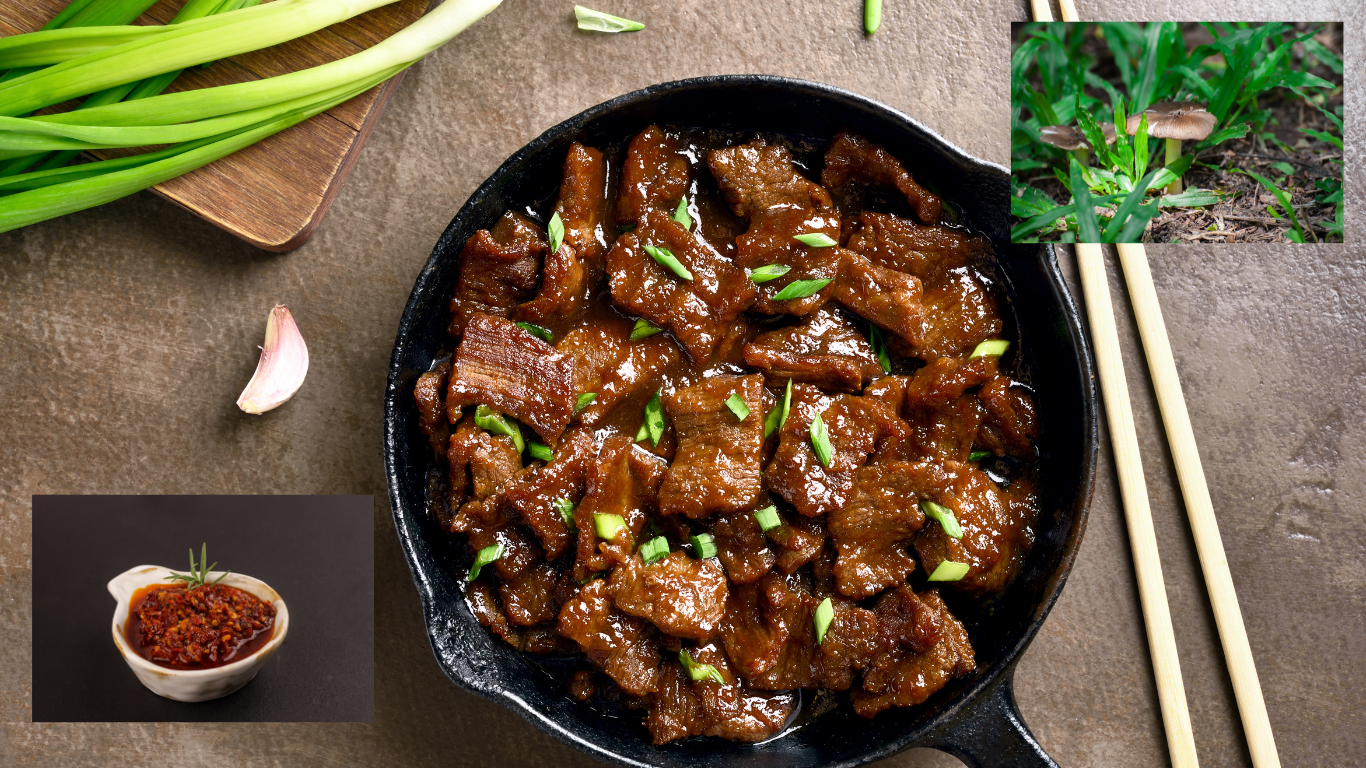Introduction.
The culinary landscape is continually evolving, with plant based diets gaining significant traction in recent years. One dish that has captured the hearts and palates of many is Mongolian “Beef.” Traditionally made with strips of beef, this dish is known for its savory, slightly sweet flavor profile. However, in this article, we will explore a delightful vegan alternative that utilizes soy chunks and mushrooms, drenched in a sweet soy glaze, served alongside vegan rice. This recipe not only satisfies meat cravings but also brings a unique twist to a classic dish.
The Appeal of Vegan Cuisine.
The rise of vegan cuisine can be attributed to several factors: health consciousness, environmental concerns, and ethical considerations regarding animal welfare. By embracing veganism, individuals can enjoy a diverse array of flavors and textures while minimizing their impact on the planet. Dishes like Vegan Mongolian “Beef” allow for culinary creativity and experimentation, offering a satisfying meal that appeals to both vegans and non vegans alike.
Ingredients
To prepare Vegan Mongolian “Beef,” you will need the following ingredients:
For the Soy Chunks and Mushrooms
- 1 cup soy chunks (textured vegetable protein)
- 2 cups water (for rehydrating soy chunks)
- 2 tablespoons vegetable oil
- 1 cup mushrooms (shiitake, portobello, or button, sliced)
- 1 small onion, thinly sliced
- 3 cloves garlic, minced
- 1 teaspoon ginger, minced
- 1 cup bell peppers, sliced (optional)
- 2 green onions, chopped (for garnish)
For the Sweet Soy Glaze.
- 1/2 cup soy sauce (low-sodium preferred)
- 1/4 cup brown sugar or coconut sugar
- 1 tablespoon cornstarch
- 1 tablespoon rice vinegar
- 1 tablespoon sesame oil
- 1 tablespoon hoisin sauce (optional)
- 1/2 teaspoon red pepper flakes (optional)
For the Vegan Rice.
- 1 cup jasmine or basmati rice
- 2 cups water
- Salt to taste
Preparing the Soy Chunks.
To achieve the perfect texture for your Vegan Mongolian “Beef,” start by rehydrating the soy chunks:
- In a medium sized pot, bring 2 cups of water to a boil.
- Once boiling, add the soy chunks and let them simmer for about 10 minutes until they become tender.
- Drain the soy chunks and squeeze out any excess liquid. Set aside.
Cooking the Mushrooms and Vegetables.
- In a large skillet or wok, heat 2 tablespoons of vegetable oil over medium high heat.
- Add the onions and sauté for 2-3 minutes until they become translucent.
- Incorporate the minced garlic and ginger, stirring for an additional minute until fragrant.
- Add the sliced mushrooms and bell peppers (if using) to the skillet. Stir fry for about 5-7 minutes until the mushrooms are cooked and slightly caramelized.
Making the Sweet Soy Glaze.
- In a small bowl, whisk together the soy sauce, brown sugar, cornstarch, rice vinegar, sesame oil, hoisin sauce, and red pepper flakes (if using) until well combined.
- Pour the mixture into the skillet with the sauteed vegetables and bring it to a gentle simmer.
- As the sauce heats, it will begin to thicken. Stir continuously to ensure it coats the vegetables evenly.
Combining the Ingredients.
- Add the rehydrated soy chunks to the skillet, tossing them in the sweet soy glaze until fully coated.
- Allow the mixture to cook for an additional 3-5 minutes, letting the flavors meld together.
Preparing the Vegan Rice.
- Rinse the rice under cold water until the water runs clear.
- In a separate pot, combine the rinsed rice, 2 cups of water, and a pinch of salt.
- Bring the mixture to a boil, then reduce the heat to low. Cover and cook for 15-20 minutes until the rice is tender and the water is absorbed.
- Fluff the rice with a fork before serving.
Plating the Dish.
To serve, spoon a generous portion of the Vegan Mongolian “Beef” over a bed of fluffy vegan rice. Garnish with chopped green onions for an added burst of flavor and color.
Nutritional Benefits.
This Vegan Mongolian “Beef” dish is not only delicious but also packed with nutritional benefits:
- High in Protein: Soy chunks provide a rich source of plant-based protein, essential for muscle repair and overall health.
- Rich in Fiber: The addition of vegetables and mushrooms increases dietary fiber, promoting digestive health.
- Low in Saturated Fat: Compared to traditional beef, this vegan alternative is lower in saturated fat, making it heart healthy.
- Vitamins and Minerals: The variety of vegetables used contributes essential vitamins and minerals, enhancing the overall nutritional profile.
Variations and Customizations.
One of the beauties of cooking is the ability to customize recipes based on personal preferences and dietary restrictions. Here are some variations to consider for your Vegan Mongolian “Beef”:
- Add More Vegetables: Incorporate broccoli, snap peas, or carrots to increase the vegetable content and add more texture.
- Spice it Up: If you enjoy heat, consider adding sliced jalapeños or increasing the amount of red pepper flakes in the glaze.
- Different Proteins: Experiment with other plant-based proteins like tempeh or seitan for varied textures and flavors.
- Gluten-Free Option: Use tamari instead of soy sauce and ensure your soy chunks are gluten free if you’re following a gluten-free diet.
Pairing Suggestions.
Vegan Mongolian “Beef” pairs wonderfully with various side dishes. Here are some ideas to complement your meal:
- Steamed Vegetables: A medley of steamed broccoli, carrots, and snow peas adds freshness and color.
- Spring Rolls: Crispy vegetable spring rolls provide a delightful crunch.
- Miso Soup: A warm bowl of miso soup can be a soothing addition to your meal.
- Asian Slaw: A tangy slaw made with cabbage, carrots, and a sesame dressing brings a refreshing contrast.
Conclusion.
Vegan Mongolian “Beef” is a delectable dish that showcases the versatility of plant based ingredients. By substituting traditional beef with soy chunks and mushrooms, you can enjoy the sweet and savory flavors of this classic recipe without compromising your dietary choices. Whether you’re a long-time vegan or simply looking to incorporate more plant-based meals into your diet, this dish is sure to impress.
Questions and Answers.
1. Can I use fresh mushrooms instead of canned or dried?
Yes, fresh mushrooms are ideal for this recipe and can enhance the flavor and texture of the dish.
2. What can I use as a substitute for soy sauce?
If you need a soy sauce substitute, consider using tamari for a gluten-free option or coconut aminos for a lower sodium alternative.
3. Can I make this dish ahead of time?
Yes, you can prepare the components of this dish ahead of time. Store the cooked soy chunks and mushroom mixture in an airtight container in the refrigerator for up to three days. Reheat before serving.
4. How do I store leftovers?
Leftovers can be stored in an airtight container in the refrigerator for up to four days. Reheat in the microwave or on the stovetop before serving.
5. Can I freeze this dish?
Yes, you can freeze the Vegan Mongolian “Beef” for up to three months. Make sure to store it in an airtight container and thaw it in the refrigerator before reheating.
With this comprehensive recipe and guide, you’re now equipped to create a delicious Vegan Mongolian “Beef” dish that everyone can enjoy. Happy cooking!

